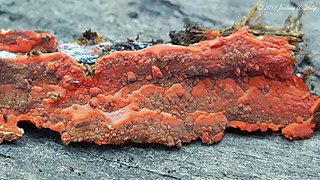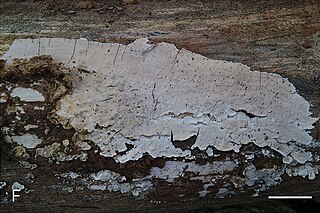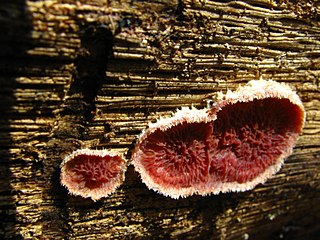
Amanita porphyria, also known as the grey veiled amanita or the porphyry amanita, is a fairly common, inedible mushroom of the genus Amanita found in Europe and North America.

Lewis David de Schweinitz was a German-American botanist and mycologist from Bethlehem, Pennsylvania. Considered the "Father of North American Mycology," he also made significant contributions to botany.

Jessen is a municipality on the Black Elster river and lies in the eastern part of Saxony-Anhalt in the district of Wittenberg.

Emil Alexander de Schweinitz was an American bacteriologist.

Deutschneudorf is a municipality in the district Erzgebirgskreis, in Saxony, Germany.

Helianthus schweinitzii is a perennial wildflower endemic to the Piedmont physiographic province of North Carolina and South Carolina. Its common name is Schweinitz's sunflower. It is a member of the sunflower family (Asteraceae). It is one of the rarest species of sunflower in the United States. It is common along utility and highway rights-of-way in North Carolina and South Carolina. There are only about 90 known populations, many containing less than 40 plants each. The U.S. Fish and Wildlife Service listed Schweinitz's sunflower as an endangered species on May 7, 1991.
Johannes Baptista von Albertini was a German botanist, mycologist and clergyman of the Moravian Church. He was born in the town of Neuwied.

Cantharellus lateritius, commonly known as the smooth chanterelle, is a species of edible fungus in the mushroom family Cantharellaceae. The species has a complex taxonomic history, and has undergone several name changes since its first description by American mycologist Lewis David de Schweinitz in 1822. The fruit bodies of the fungus are brightly colored yellow to orange, and usually highly conspicuous against the soil in which they are found. At maturity, the mushroom resembles a filled funnel with the spore-bearing surface along the sloping outer sides. The texture of the fertile undersurface (hymenium) of the caps is a distinguishing characteristic of the species: unlike the well-known golden chanterelle, the hymenium of C. lateritius is much smoother.
Schweinitz is a village in Saxony-Anhalt, Germany.
Wolfgang von Schweinitz is a German composer of classical music and an academic teacher.

Félix de Lapersonne was a French ophthalmologist.

Boletinellus merulioides, commonly known as the ash-tree bolete, is a species of bolete fungus in the family Boletinellaceae. Described as new to science in 1832, it is found in Asia and eastern North America, where it grows on the ground near ash trees.

Phlebia incarnata is a species of polypore fungus in the family Meruliaceae. It is inedible.

Polyporus radicatus is a species of fungus in the family Polyporaceae. It was described as new to science by German-American botanist Lewis David de Schweinitz in 1832. It is found in North America, including Mexico. It grows on the ground, probably from buried roots or originating from sclerotia. Its spores are more or less ellipsoid to spindle shaped, measuring 12–15 by 6–8 μm. It is inedible.

Phlebia coccineofulva, commonly known as the scarlet waxcrust, is a species of crust fungus in the family Meruliaceae. It was described as a new species by Lewis David de Schweinitz in 1832. The fungus is found in North America, continental Europe, and northern Asia, where it grows as a saprophyte on decaying stumps and woody forest debris.

Datroniella scutellata is a species of fungus in the family Polyporaceae, and the type species of genus Datroniella.

Lopharia cinerascens is a species of crust fungus in the family Polyporaceae. It was first described by botanist Lewis David de Schweinitz in 1832 as Thelephora cinerascens. Gordon Herriot Cunningham transferred it to Lopharia in 1956. It is widely distributed in Africa, Asia, Australasia, and North America; it is less common in Europe and South America.

Diderma effusum is a species of slime mould in the family Didymiaceae, first described by Lewis David de Schweinitz in 1832 as Physarum effusum, and transferred to the genus, Diderma, in 1894 by Andrew Price Morgan. It is found throughout the world, It feeds on nonliving organic matter.
Anixia interrupta is a species of fungus belonging to the genus Anixia. It was documented in 1832 by German-American mycologist Lewis David de Schweinitz.

Punctularia strigosozonata is a fungus species of the genus Punctularia. It was originally described in 1832 by Lewis David de Schweinitz as a member of genus Merulius. Patrick Talbot transferred it to genus Punctularia in 1958. Punctularia strigosozonata produces the antibiotic phlebiarubrone.
















